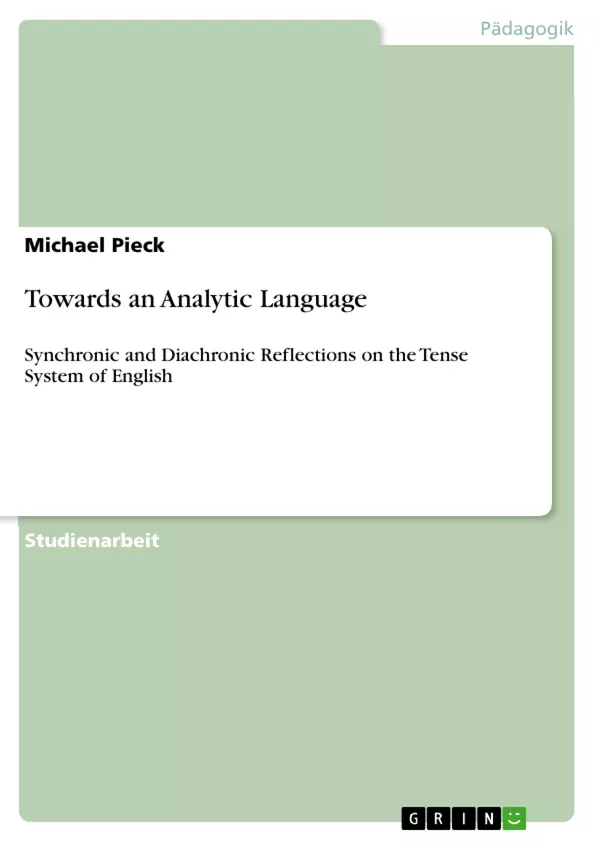The terms ‘synthetic language’ and ‘analytic language’ in connection with linguistic typo?logy have become commonplaces in contemporary lingusitics. They refer to morphological or rather morpho-syntactic characteristics of languages. “Whereas analytic languages have very few affixes (for example, Modern English), synthetic languages have many (for example, Latin, Old English).” (O’Grady et al. 1997: 334) Using the quantifiers ‘very few’ and ‘many’, this definition by O’Grady et al. shows that it might be problematic to speak about synthetic and analytic languages as ‘fixed’ or ‘closed categories’ in a structuralist way. They rather denote prototypical categories or general tendencies, as there is hardly any language which entirely belongs to one or the other category. Even a prototypically analytic language like Present-Day English (PDE) has both grammaticalized synthetic elements and tendencies towards new syntheticity, as O’Grady et al. or Danchev have shown.
In a synthetic language, four lexiacal categories are usually concerned with inflectio?n: verbs, nouns, pronouns and adjectives. Since Old English, the earliest stage of the English language, the inflectional system has continuously been reduced, and in PDE most grammatical relations are expressed through analytic constructions. The tense system of Old English consisted of two morphologically marked tenses, the present and the preterite. Futurity could be expressed through ‘futurate’ constructions employing present tense or, rarely, be supported by a certain set of lexical verbs functioning as auxiliaries without losing their lexical meaning, e.g. willan = to want, or sculan = must. These verbs were, unlike today, fully inflected.
(…)
This paper will show that the decline of the inflectional system made it quasi necessary to create and strengthen analytic verb forms and finally grammaticalize them. The outcome of this process is the great variety of ways to express temporal relationships and aspects, as we have them in Present-Day English. The fundament of the English language may remain synthetic, however, the ‘construction above’ is clearly analytic.
Inhaltsverzeichnis
- Introduction
- Tense, Aspect and Modality
- The Dichotomy of Synthetic and Analytic
- General Considerations
- The Origins
- A Note on Diachrony and the Periodization of English
- The Development of Tenses
- Present Tense - Synchronic Aspects
- Present Tense in Old English
- Present Tense in Middle English
- Present Tense in Early Modern English
- Past Tense - Synchronic Aspects
- Past Tense in Old English
- Past Tense in Middle English
- Past Tense in Early Modern English
- Future Tense - Synchronic Aspects
- Future Tense in Old English
- Future Tense in Middle English
- Future Tense in Early Modern English
- Present Tense - Synchronic Aspects
- The Development of Aspects
- Synchronic Presentation of the Perfective Aspect
- Diachronic Presentation of the Perfective Aspect
- Synchronic Presentation of the Progressive Aspect
- Diachronic Presentation of the Progressive Aspect
Zielsetzung und Themenschwerpunkte
Diese Hausarbeit befasst sich mit der Entwicklung des englischen Tempussystems von seinen Anfängen im Altenglischen bis hin zum modernen Englisch. Dabei werden sowohl synchrone als auch diachrone Aspekte betrachtet, wobei der Fokus auf die Entstehung und Grammatikalisierung analytischer Verbformen im Verlauf des Sprachwandels liegt. Die Arbeit analysiert, wie die Reduktion des Flexionssystems im Englischen zur Entwicklung neuer, analytischer Mittel zur Ausdruck von Zeit und Aspekt führte.
- Der Wandel vom synthetischen zum analytischen Sprachtyp im Englischen
- Die Entwicklung des Tempussystems von Altenglisch bis zum modernen Englisch
- Die Rolle von Flexionsreduktion und Grammatikalisierung analytischer Verbformen
- Die Beziehung zwischen Syntax und Morphologie im Sprachwandel
- Die Bedeutung der analytischen Verbformen für die moderne englische Grammatik
Zusammenfassung der Kapitel
Die Einleitung stellt die Arbeit und ihre Thematik vor. Sie diskutiert die Begriffe „synthetische Sprache“ und „analytische Sprache“ und erläutert, wie sich diese Kategorien im Laufe der Zeit entwickelt haben. Die Arbeit setzt den Fokus auf die diachrone Entwicklung des englischen Tempussystems und untersucht, wie es im Laufe der Geschichte zu einem Wandel von einem synthetischen zu einem analytischeren Sprachtyp kam.
Kapitel 2 beschäftigt sich mit den Begriffen „Tempus“ und „Aspekt“ im modernen Englisch und definiert diese anhand ihrer morphologischen Eigenschaften. Es stellt fest, dass die einfachen Vergangenheits- und Gegenwartsformen als die einzigen Tempora im modernen Englisch gelten, während die perfektiven und progressiven Verbformen zum Aspekt gehören. Der Beitrag präsentiert die Argumentation für die Einstufung des Futurs als dritte Tempusform im modernen Englisch und skizziert den Fokus der Untersuchung, der auf der Entwicklung der sogenannten Primärtempora, Gegenwart und Vergangenheit, sowie auf futuristischen und modalen Konstruktionen liegt.
Kapitel 3 behandelt die Typologie synthetischer und analytischer Sprachen. Es erläutert verschiedene typologische Unterscheidungen und diskutiert die Frage, ob Sprachen eindeutig einer Kategorie zuzuordnen sind. Der Beitrag stellt die Begriffsgeschichte der Begriffe „synthetische Sprache“ und „analytische Sprache“ dar und zeigt, wie diese Kategorien in der frühen Sprachwissenschaft entstanden sind.
Kapitel 4 behandelt die Diachronie und Periodisierung der englischen Sprache. Es erläutert verschiedene Theorien zur Einordnung des Englischen in eine bestimmte Sprachepoche und gibt einen kurzen Überblick über die verschiedenen Stadien der Sprachentwicklung.
Kapitel 5 beleuchtet die Entwicklung der Tempora im Englischen. Es analysiert die synchrone und diachrone Verwendung der Gegenwarts-, Vergangenheits- und Zukunftsformen im Altenglischen, Mittelenglischen und Frühneuenglischen.
Kapitel 6 untersucht die Entwicklung des Aspekts im Englischen. Es beleuchtet die synchrone und diachrone Verwendung des perfektiven und progressiven Aspekts im Englischen und diskutiert die Bedeutung dieser Kategorien für die moderne englische Grammatik.
Schlüsselwörter
Die zentralen Schlüsselwörter dieser Arbeit sind: synthetische Sprache, analytische Sprache, Tempus, Aspekt, Grammatikalisierung, Sprachwandel, Altenglisch, Mittelenglisch, Frühneuenglisch, Flexion, morphologische Eigenschaften, diachrone Linguistik, synchrone Linguistik.
- Arbeit zitieren
- Michael Pieck (Autor:in), 2010, Towards an Analytic Language, München, GRIN Verlag, https://www.grin.com/document/171511



